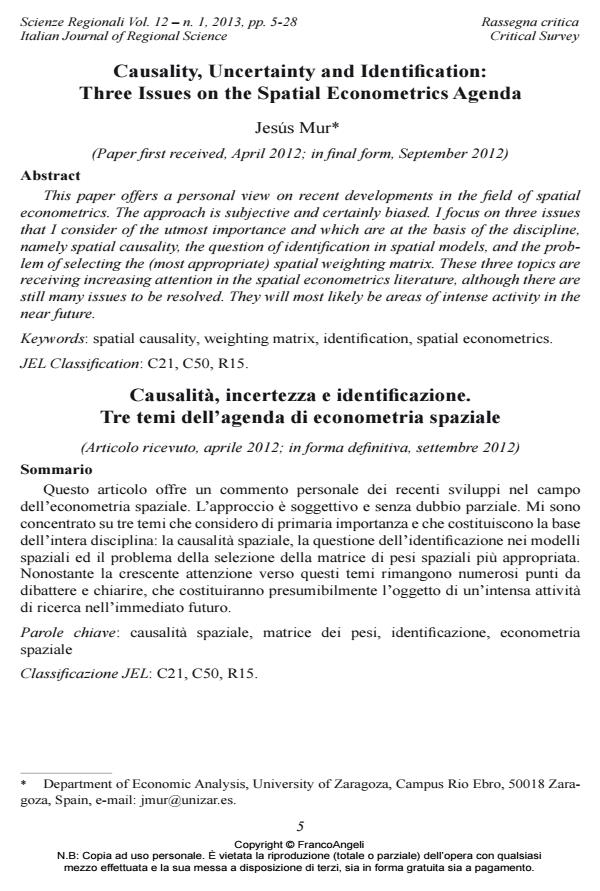Causality, Uncertainty and Identification: Three Issues on the Spatial Econometrics Agenda
Titolo Rivista SCIENZE REGIONALI
Autori/Curatori Jesùs Mur
Anno di pubblicazione 2013 Fascicolo 2013/1
Lingua Inglese Numero pagine 23 P. 5-27 Dimensione file 993 KB
DOI 10.3280/SCRE2013-001001
Il DOI è il codice a barre della proprietà intellettuale: per saperne di più
clicca qui
Qui sotto puoi vedere in anteprima la prima pagina di questo articolo.
Se questo articolo ti interessa, lo puoi acquistare (e scaricare in formato pdf) seguendo le facili indicazioni per acquistare il download credit. Acquista Download Credits per scaricare questo Articolo in formato PDF

FrancoAngeli è membro della Publishers International Linking Association, Inc (PILA)associazione indipendente e non profit per facilitare (attraverso i servizi tecnologici implementati da CrossRef.org) l’accesso degli studiosi ai contenuti digitali nelle pubblicazioni professionali e scientifiche
This paper offers a personal view on recent developments in the field of spatial econometrics. The approach is subjective and certainly biased. I focus on three issues that I consider of the utmost importance and which are at the basis of the discipline, namely spatial causality, the question of identification in spatial models, and the problem of selecting the (most appropriate) spatial weighting matrix. These three topics are receiving increasing attention in the spatial econometrics literature, although there are still many issues to be resolved. They will most likely be areas of intense activity in the near future.
Questo articolo offre un commento personale dei recenti sviluppi nel campo dell’econometria spaziale. L’approccio è soggettivo e senza dubbio parziale. Mi sono concentrato su tre temi che considero di primaria importanza e che costituiscono la base dell’intera disciplina: la causalità spaziale, la questione dell’identificazione nei modelli spaziali ed il problema della selezione della matrice di pesi spaziali più appropriata. Nonostante la crescente attenzione verso questi temi rimangono numerosi punti da dibattere e chiarire, che costituiranno presumibilmente l’oggetto di un’intensa attività di ricerca nell’immediato futuro.
Parole chiave:Causalità spaziale, matrice dei pesi, identificazione, econometria spaziale Classificazione
Jel codes:C21, C50, R15
- Spatial analysis of the participation in agri-environment measures for organic farming Fabio Boncinelli, Fabio Bartolini, Gianluca Brunori, Leonardo Casini, in Renewable Agriculture and Food Systems /2016 pp.375
DOI: 10.1017/S1742170515000307 - Identification of Spatial Spillovers: Do's and Don'ts Nicolas Debarsy, Julie Le Gallo, in Journal of Economic Surveys /2025 pp.2152
DOI: 10.1111/joes.12692 - The Empirical Content of Spatial Spillovers: Identification Issues Nicolas Debarsy, Julie Le Gallo, in SSRN Electronic Journal /2024
DOI: 10.2139/ssrn.4751335
Jesùs Mur, Causality, Uncertainty and Identification: Three Issues on the Spatial Econometrics Agenda in "SCIENZE REGIONALI " 1/2013, pp 5-27, DOI: 10.3280/SCRE2013-001001